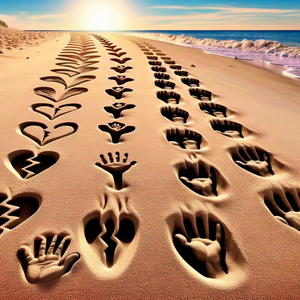From Intern to Innovator: Real Stories of Successful Entry-Level UX Designers

For many entry-level UX designers, the journey often starts with internships. Take Sarah, for example, who landed her first internship at a small tech startup. “I had no formal experience, but I was passionate about design and eager to learn,” she recalls. Her willingness to embrace opportunities, even in a less-than-ideal work environment, allowed her to gain hands-on experience that would prove crucial in her career. Sarah emphasizes the importance of being open to any role that allows you to engage with the design process, regardless of the company's size or reputation. This approach is echoed by many successful designers; internships often serve as the gateway to full-time positions, providing invaluable experience and networking opportunities. According to recent data, entry-level UX designer jobs are increasingly competitive, making internships a vital stepping stone for aspiring designers.
Facing Challenges: The Reality of Entry-Level Positions
The transition from student to professional can be daunting. Many designers, like James, faced challenges that tested their resilience. “My first project was overwhelming; I was tasked with redesigning an entire application,” he admits. With limited guidance and high expectations, James learned to seek feedback proactively and collaborate with more experienced team members. He stresses the importance of communication in overcoming obstacles, stating, “Don’t hesitate to ask for help. It’s how you learn and grow.” The reality is that entry-level positions often come with steep learning curves. Many designers experience imposter syndrome, feeling unqualified despite their education and skills. This challenge is common but can be mitigated through consistent communication and collaboration, enabling newcomers to thrive in a professional environment.
Building a Network: The Power of Connections
Networking is often cited as a key factor in career development, and for Emma, it was a game changer. Starting her career in UX design, Emma attended various industry meetups and conferences. “I met some incredible people who became mentors and friends. Their guidance helped me navigate the early stages of my career,” she shares. Emma's story illustrates the significance of building relationships in the design community. By actively participating in networking events, aspiring designers can gain valuable insights and potentially open doors to job opportunities. According to a report from the Nielsen Norman Group, nearly 70% of jobs in the UX industry are filled through networking and referrals. As such, investing time in building a strong professional network can be just as important as technical skills.
Lessons in Adaptability: Learning from Failure
Failure is an inevitable part of any career. For Michael, a UX designer who transitioned from a different field, his initial attempts to break into UX were met with rejection. “I applied for over 50 jobs before landing my first role,” he recalls. Instead of becoming discouraged, Michael took each rejection as a learning opportunity. He sought feedback on his portfolio and made necessary adjustments. His experience underscores the importance of adaptability and resilience in the face of setbacks. “Every ‘no’ brought me closer to a ‘yes’,” he reflects. This sentiment is echoed by many successful designers who view rejection not as a failure but as a stepping stone toward personal and professional growth.
Finding Your Niche: Specialization and Growth
As designers gain experience, finding a niche can be a pivotal moment in their careers. For Rachel, this meant discovering her passion for accessibility in design. “I realized that many products were not user-friendly for people with disabilities, and I wanted to make a difference,” she explains. By specializing in accessibility, Rachel not only found fulfillment in her work but also positioned herself as an expert in a growing field. Her journey highlights the importance of exploring different aspects of UX design to find what resonates most with you. As the industry continues to evolve, niches like accessibility, usability, and interaction design are becoming increasingly important, allowing designers to carve out unique identities and expertise within the broader field.
The stories of these successful entry-level UX designers showcase the diverse paths and experiences that lead to success in the field. From embracing opportunities and facing challenges to building networks and specializing in niche areas, each journey is unique yet interconnected by common themes. For aspiring UX designers, these narratives serve as a reminder that the path may not always be straightforward, but with determination, adaptability, and a willingness to learn, it is possible to transform from an intern to an innovator in the world of UX design. As you embark on your own journey, remember: every experience, even the challenging ones, contributes to your growth and ultimately shapes your career. The UX design field is not only about creating user-friendly products; it's about understanding human behavior, embracing challenges, building connections, and continuously evolving as a designer. Embrace your journey, and you too can become an innovator in this exciting field.
User Experience Researcher
Google, Amazon
Core Responsibilities
Conduct qualitative and quantitative research to understand user needs and behaviors.
Analyze data to identify trends and provide actionable insights to design teams.
Collaborate with UX designers and product managers to ensure research findings inform design decisions.
Required Skills
Proficiency in research methodologies, including interviews, surveys, usability testing, and A/B testing.
Strong analytical skills with the ability to synthesize complex data into clear reports.
Familiarity with tools such as UserTesting, Optimal Workshop, and various analytics platforms.
Common Employers
Tech giants like Google and Amazon, as well as consulting firms and startups focused on user-centric design.
Interaction Designer
Slack
Core Responsibilities
Design interactive elements for web and mobile applications, focusing on user flow and usability.
Create wireframes, prototypes, and high-fidelity mockups to visualize design concepts.
Collaborate with developers to ensure that designs are implemented accurately and effectively.
Required Skills
Proficiency in design software such as Sketch, Figma, and Adobe XD.
Strong understanding of user-centered design principles and interaction design patterns.
Experience with prototyping tools such as InVision or Axure.
Common Employers
Digital agencies, product-based companies like Slack, and e-commerce platforms.
Accessibility Specialist
Core Responsibilities
Assess digital products for compliance with accessibility standards (e.g., WCAG).
Provide recommendations for making products more accessible to users with disabilities.
Conduct training sessions for design and development teams on inclusive design practices.
Required Skills
In-depth knowledge of accessibility laws and guidelines, as well as assistive technologies.
Ability to conduct accessibility audits and create detailed reports on findings.
Familiarity with design tools that support accessibility features (e.g., ARIA markup).
Common Employers
Non-profit organizations, educational institutions, and tech companies committed to inclusive design.
UX/UI Designer
Facebook, Microsoft
Core Responsibilities
Design user interfaces and experiences for web and mobile applications, balancing aesthetics and functionality.
Collaborate with stakeholders to gather requirements and translate them into design solutions.
Conduct user testing to gather feedback and iterate on designs based on user insights.
Required Skills
Strong proficiency in visual design tools like Adobe Creative Suite and Figma.
Understanding of front-end development (HTML, CSS, JavaScript) to work effectively with developers.
Ability to create style guides and design systems to ensure consistency across products.
Common Employers
Startups, large tech companies like Facebook and Microsoft, as well as design consultancies.
Product Designer
Airbnb
Core Responsibilities
Lead the end-to-end design process for products, from ideation to implementation and post-launch evaluation.
Collaborate with cross-functional teams, including marketing, engineering, and product management.
Balance user needs with business goals to create engaging and effective product experiences.
Required Skills
Strong portfolio showcasing a range of design work and problem-solving skills.
Experience with user research, prototyping, and usability testing.
Excellent communication skills to articulate design decisions to stakeholders.
Common Employers
High-growth startups, established tech companies like Airbnb, and product design agencies.


